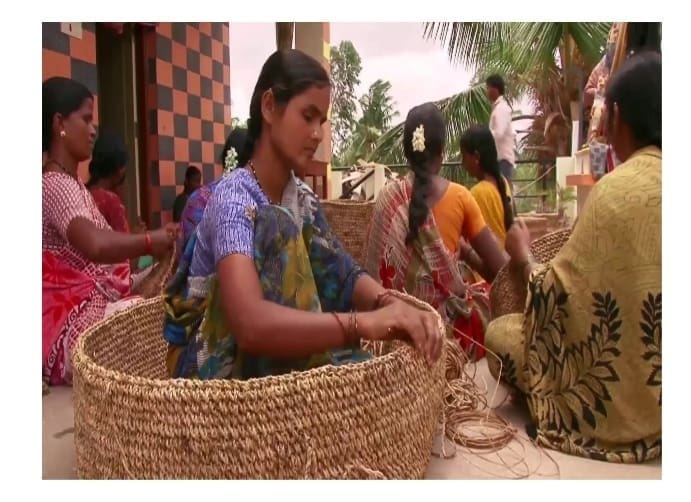The Go Swadeshi Online showcases a handloom and handicraft products
An online sale of handlooms and crafts, Go Swadeshi Online, is an initiative by GoCoop to support artisans. “We wanted to help the sector recover from the impact of COVID-19,” says Siva Devireddy, founder of GoCoop. The sale, which started on May 21, and will be on till May 27, showcases a wide range of handloom saris, fabric, dress material, stoles, dupattas, menswear and home decor products. Devireddy, in an interview with MetroPlus, gives a bigger picture of the India’s handloom tradition. Excerpts.
Could you talk about the genesis of Go Swadeshi Online?
Being the first online marketplace platform for weavers and artisans and a national award winner for handlooms marketing, it is not only our responsibility but also our duty to support our weaver and artisan communities during this crisis. Helping weavers sell their stock at this time would immediately give some cash flow to these small groups, entrepreneurs and co-ops. This is the best we can do apart from supporting them with sustenance which is coming from the government and other social initiatives. I also feel it is our collective responsibility to support our weaver and artisan communities in this time of crisis. Buying handloom and handicrafts would go a long way in supporting and sustaining the craft community.
How many co-operatives and weavers do you work with? How does the portal work?
GoCoop currently works with 350 co-ops, weaver entrepreneurs and craft-based organisations across India through our online marketplace, offline exhibitions and wholesale business. Each seller on the platform including co-operatives, small master weavers/ entrepreneurs and NGOs register online (or offline), create their own page, upload their products (based on their pricing) and can sell directly to customers in India and 14 countries. Our team provides the training and hand-holding through the entire process. We market these craft-clusters across categories online and generate demand, both from consumers and bulk buyers.
We currently have a base of over 50,000 consumers and over 1,000 bulk or wholesale buyers. The orders placed on the platform are directly shared with the sellers and our team works closely with the sellers in the quality assurance and fulfilment through our international and domestic logistic partners.
What has been the weavers’ reaction to going online?
We have over 600 handloom clusters in India and over 3.1 million weaver households (as per the recent handloom census). Many of these small clusters are in remote locations and consist of weavers, weaver entrepreneurs, co-operatives and social organisations. In our journey over the last eight years, we have seen a lot of resistance in coming online as most of the weavers were comfortable selling their products at exhibitions and to local buyers. Over the last two months, due the current crisis, the craft community is seeing a greater need to come online. During the lockdown period, we saw a lot of interest and have been working with many small entrepreneurs, co-ops and educating them about online business and supporting them in coming online. Seeing the interest from the craft community, we launched a new initiative, Local se Global tak, a three-part webinar series to bring craft entrepreneurs and organisations online. We are hoping to bring at least 1,000 craft entrepreneurs and organisations online in the next six months.
Is there a lot of unsold-inventory with the weavers?
Within our network, we did a study of stocks of 69 small weaver co-ops and entrepreneurs. Most of them have reported significant pile-up of stock due to the lockdown. Markets were closed and with no exhibitions, most bulk orders have been put on hold. Even small weaver entrepreneurs have stock worth ₹15 lakh and some of the bigger organisations have stocks worth over ₹50 lakh.
How did this pile up of stock happen?
Weavers produce all year round and sell their products in the festive season through exhibitions. As there were no sales during the last festive season (Holi and Ugadi), most of the stocks have piled up. In some cases, bulk orders have been put on hold and this also added to their on-hand inventory.
Weavers do not earn much.What is Go Coop doing to help them?
According to a recent handloom survey, over 66% of weavers earn less than ₹5,000 a month which averages less than ₹ 200 a day. In many cases skilled artisans earn less than manual labour. The main reasons for this is the long value chains in this industry, competition from other mass-produced textile products, less focus on product design and development, and lack of proper branding and marketing of handloom products.
GoCoop connects weavers, artisans, co-ops and craft-based organisations directly with buyers. This way both buyers and artisans are able to realise a better price. GoCoop also imparts training on understanding consumer demand and design trends. We also offer support in product design and development. Through GoCoop, a co-op or master weaver is able to create their own identity, showcase their products, and connect directly with customers not only in India but across the world. It is sometimes difficult to imagine that a weaver co-op or entrepreneur from Chhattisgarh is able to directly sell their products to a consumer in San Francisco. This is what digital empowerment is all about.

